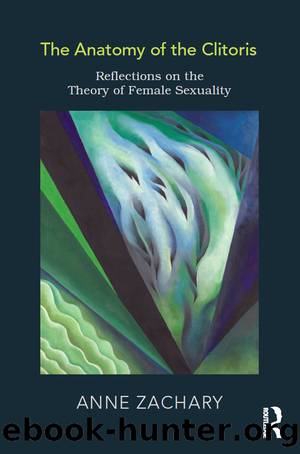The Anatomy of the Clitoris by Anne Zachary

Author:Anne Zachary [Неизв.]
Language: eng
Format: epub, pdf
ISBN: 9780429840791
Publisher: Taylor & Francis (CAM)
Their definition of sexuality is then quite broad, embracing this and all the components of sexual activity that go beyond genital functioning or fulfilling basic biological needs, as well as, of course, object choice. They do not define gender separately.
Gender is a biological and not a psychoanalytic term, derived from âgenusâ, a collective heading under which there are common overall attributes such as male and female, which then further classifies different species and more specifically families. In some languages, nouns are designated masculine, feminine, or neuter, which could be seen as a parallel with bisexuality. Gender identity will be determined by a variety of multicultural phenomena, and in The Gender Conundrum, Greensonâs chapter refers to the establishment of gender as relatively nebulous, listing three basic determinants. These are: a) awareness of anatomical and physiological structures (Greenacre adds, primarily the face and the genitals); b) assignment to a specific gender by the parents and other important social figures; and c) a biological force present from birth which can (described by Stoller in transsexuals and illustrated by the AIS patients above) be strong enough to counteract both a) and b). Greenson adds a fourth, d) the disidentification from mother and the identification with father in boys which, of course, mother must allow (Birksted-Breen, 1993, p. 262). Stollerâs idea is that it can be the unconscious wish on the motherâs part for her son to be a girl that contributes to the childhood creation of a transsexual and an explanation for their names so often being sexually ambiguous (for example, Toni, Nikki).
The Gender Conundrum starts with Freudâs statement, âIt is important to understand clearly that the concepts of âmasculineâ and âfeminineâ whose meaning seems so unambiguous to ordinary people, are amongst the most confused that occur in scienceâ (1993, p. 1). Birksted-Breen says, âAs with femininity, Freud felt that, although fundamental, the concept of bisexuality was impregnated with obscurityâ (p. 231). Leaving bisexuality, about which she says that there is relatively little written, until the last section, she begins there with âBisexuality brings to the foreground again the question of the relationship of body and mind, of biological bisexuality and psychological bisexualityâ (p. 231).
Birksted-Breen puts forward that there is a duality in Freudâs work; this does not mean that he was confused or changed his mind, but that the duality has a purpose of its own to contain the tensions that have existed in the debate about sexuality throughout the twentieth century. She suggests that the concept of bisexuality reflects the duality âused at times to express the biological predisposition of the human individual, while at other times Freud used it to refer to the balance of object relationshipsâ (p. 231).
Birksted-Breen argues for an âout-of-focusnessâ to be tolerated in our understanding of masculinity and femininity. The âout-of-focusness most clearly ⦠expresses the duality of Freudâs position; body and mind are connected, but not completely, and the disjunction between them is difficult to graspâ (p. 5). Acknowledging that âhuman nature is inherently bisexualâ, she
Download
This site does not store any files on its server. We only index and link to content provided by other sites. Please contact the content providers to delete copyright contents if any and email us, we'll remove relevant links or contents immediately.
| Administration & Medicine Economics | Allied Health Professions |
| Basic Sciences | Dentistry |
| History | Medical Informatics |
| Medicine | Nursing |
| Pharmacology | Psychology |
| Research | Veterinary Medicine |
Periodization Training for Sports by Tudor Bompa(7929)
Why We Sleep: Unlocking the Power of Sleep and Dreams by Matthew Walker(6362)
Paper Towns by Green John(4805)
The Immortal Life of Henrietta Lacks by Rebecca Skloot(4262)
The Sports Rules Book by Human Kinetics(4079)
Dynamic Alignment Through Imagery by Eric Franklin(3925)
ACSM's Complete Guide to Fitness & Health by ACSM(3827)
Kaplan MCAT Organic Chemistry Review: Created for MCAT 2015 (Kaplan Test Prep) by Kaplan(3804)
Introduction to Kinesiology by Shirl J. Hoffman(3628)
Livewired by David Eagleman(3535)
The River of Consciousness by Oliver Sacks(3420)
The Death of the Heart by Elizabeth Bowen(3342)
Alchemy and Alchemists by C. J. S. Thompson(3298)
Descartes' Error by Antonio Damasio(3167)
Bad Pharma by Ben Goldacre(3102)
The Emperor of All Maladies: A Biography of Cancer by Siddhartha Mukherjee(2932)
The Gene: An Intimate History by Siddhartha Mukherjee(2929)
The Fate of Rome: Climate, Disease, and the End of an Empire (The Princeton History of the Ancient World) by Kyle Harper(2877)
Kaplan MCAT Behavioral Sciences Review: Created for MCAT 2015 (Kaplan Test Prep) by Kaplan(2819)
